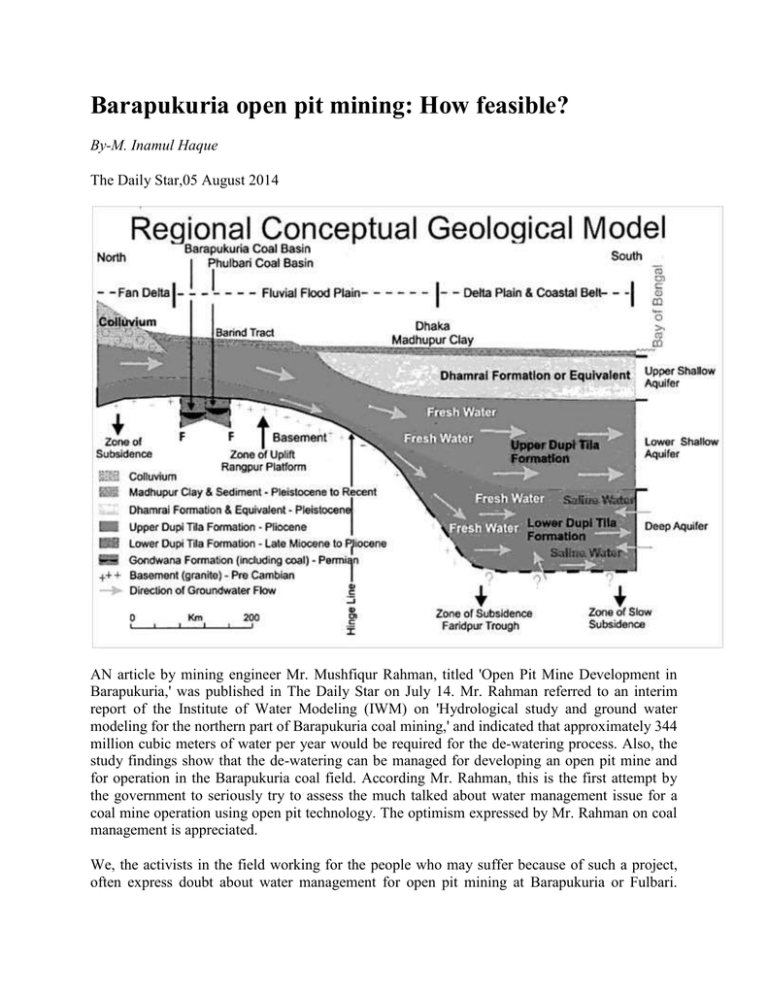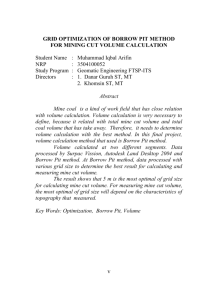Barapukuria_open_pit_mining
advertisement

Barapukuria open pit mining: How feasible? By-M. Inamul Haque The Daily Star,05 August 2014 AN article by mining engineer Mr. Mushfiqur Rahman, titled 'Open Pit Mine Development in Barapukuria,' was published in The Daily Star on July 14. Mr. Rahman referred to an interim report of the Institute of Water Modeling (IWM) on 'Hydrological study and ground water modeling for the northern part of Barapukuria coal mining,' and indicated that approximately 344 million cubic meters of water per year would be required for the de-watering process. Also, the study findings show that the de-watering can be managed for developing an open pit mine and for operation in the Barapukuria coal field. According Mr. Rahman, this is the first attempt by the government to seriously try to assess the much talked about water management issue for a coal mine operation using open pit technology. The optimism expressed by Mr. Rahman on coal management is appreciated. We, the activists in the field working for the people who may suffer because of such a project, often express doubt about water management for open pit mining at Barapukuria or Fulbari. State Minister for Power Energy and Mineral Resources Mr. Nasrul Hamid disclosed on July 10 that the government has decided to start a “small open pit coal mine” in the northern part of Barapukuria Coal Field, Dinajpur. The mine may feed a 1,300 MW mine-mouth coal fired power plant. The minister wishes to commence building the open pit mine within three months. This attempt seems to be very pragmatic at first glance, but we know that an open pit mine deeper than 100m is not economically feasible. The bituminous coal layer at Barapukuria and Fulbari lie 118m to 503m deep in the shape of boats. There, the underground water pressure on the Dupi Tila formation is so heavy that consultant Wardell Armstrong, in May 1991, suggested well and tunnel method for extraction. Experts in our country often cite the example of Hambach Cologne open pit mine in Germany. But there, coal of lignite quality lies at a 100m to 500m deep slope. They open a pit at 100m and then extract the rest by tunneling. Underground water pressure is also not very strong there, so it can be managed by pumping. At Barapukuria, two 6m diameter metal shafts were dug at depths of 326 and 320 meters; roadways in several directions were built from their bottom for coal extraction by Long Wall Top Coal Caving method. After expiry of the contract with the Machinery Export and Import Company (CMC) on August 31, 2011, a new contract for Management, Production, Maintenance & Provisioning Services (MPM&P) was signed with the consortium of CMC and Xuzhou Coal Mining Group Corporation (XMC). The Barapukuria Coal Mining Company Limited (BCMCL) website has the following extraction figures. The Barapukuria coal deposit lies in six layers between sandstone and mudstone, of which one layer is 36m thick. This bituminous coal has only 0.53% sulphur, so it is ideal for power generation. But the extraction method applied has some drawbacks; it does not sand-fill the empty chambers, as a result of which land subsidence can occur. A large area in Hamidpur Union is now under water due to such subsidence. Secondly, not more than 50% coal can be extracted by long tunnel method. To extract full amount of coal from the deposit, open pit mining is suggested. IWM interim study finds open pit mining is possible at Barapukuria. But, is it really possible practically? We, the environmental activists, always suggest that four steps be taken during studies for any type of development project: Economic Viability, Technical Feasibility, Social Acceptability, and Environmental Impact. Open pit mining at Barapukuria may look economically viable; but its land cost, excavation cost, dewatering cost, operation cost etc., may exceed the benefit to be achieved. IWM may find 344 million cubic meters of water dewatering per year possible by calculation, but may not be possible in reality. For social acceptability, what alternate livelihood and compensation are offered to the to-be-affected people? Finally, we cannot ignore the multifarious environmental impacts. If all those studies are done properly and made open to the public, there remains no ambiguity; and then only, a project will not bring disaster but joy to all stakeholders. The writer is Chairman, Email: minamul@gmail.com Institute of Water & Environment.





